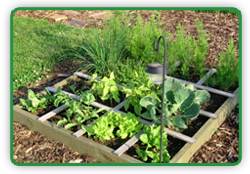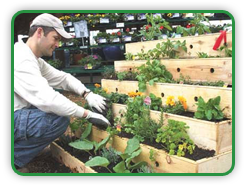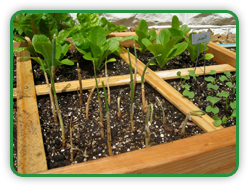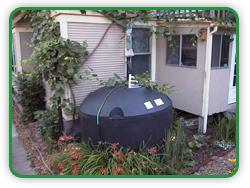|
Home > Guides > Urban Gardening > Square Foot Gardening > Efficient Gardening |
|
Efficient Gardening |
Efficient  Small Scale Small Scale  Limited Space Limited Space |
It is little secret that an overwhelming proportion of the food we consume on a daily basis is grown in rural areas. These locations offer an abundance of space and natural sunlight, which facilitates the rapid growth and maturation of the vast majority of common edibles. Urban areas, on the other hand, are generally not considered ideal environments for the cultivation of edible fruits and vegetables because of the small space available. Such environments have limited space, are dominated by concrete and glass rather than soil, and setting up spaces devoted to growing edible plants requires careful planning in making the most of every available square foot to get the maximum yield possible.
|
 |
|
|
| |
|
|
| |
|
|
| |
Square Foot Gardening
 Despite the obstacles to gardening in confined spaces, increasing numbers of city dwellers and suburbanites are looking for ways to produce their own food. Whether borne of curiosity, necessity, or a desire to be more active in providing sustenance for themselves or their families, such individuals are discovering a new source of power and self-sufficiency in growing food. No longer dependant on large-scale commercial agriculture, they are learning practical skills that are sure to enrich their well-being for years to come. Despite the obstacles to gardening in confined spaces, increasing numbers of city dwellers and suburbanites are looking for ways to produce their own food. Whether borne of curiosity, necessity, or a desire to be more active in providing sustenance for themselves or their families, such individuals are discovering a new source of power and self-sufficiency in growing food. No longer dependant on large-scale commercial agriculture, they are learning practical skills that are sure to enrich their well-being for years to come.
 Fortunately, there are more resources available than ever to the space-conscious home gardener looking to become more responsible for the food they eat. Authors and teachers such as Jon Jeavons, Mel Bartholomew, Rosalind Creasy and others have devised thoughtful and often ingenious new techniques to make the most of limited space, soil, and sunlight and other resources in urban settings. In addition, a pioneering wave of home and indoor gardeners have done much to advance the science of hydroponics, or soil-less growing techniques, in the last several decades. Fortunately, there are more resources available than ever to the space-conscious home gardener looking to become more responsible for the food they eat. Authors and teachers such as Jon Jeavons, Mel Bartholomew, Rosalind Creasy and others have devised thoughtful and often ingenious new techniques to make the most of limited space, soil, and sunlight and other resources in urban settings. In addition, a pioneering wave of home and indoor gardeners have done much to advance the science of hydroponics, or soil-less growing techniques, in the last several decades.
|
| |
|
|
|
| |
|
|
|
|
Efficient Gardening
 Growing food in limited spaces such as urban or suburban settings requires careful planning and prudent use of resources at hand: principally space, soil, light and time. To make the most out of such a space, efficient techniques can be employed to make optimum use of available resources. Succession planning can be utilized with many crops to ensure a continual supply of edibles throughout the season. Crop rotations should be undertaken regularly to provide relief from the strains that heavy feeders, such as tomatoes, can place upon the soil. Moreover, the gardener who practices these techniques develops a keen understanding of the attributes and qualities of their specific growing space. They constantly look for ways to manifest greater efficiency, flow, and production while negating, or even transforming, supposed limitations. Growing food in limited spaces such as urban or suburban settings requires careful planning and prudent use of resources at hand: principally space, soil, light and time. To make the most out of such a space, efficient techniques can be employed to make optimum use of available resources. Succession planning can be utilized with many crops to ensure a continual supply of edibles throughout the season. Crop rotations should be undertaken regularly to provide relief from the strains that heavy feeders, such as tomatoes, can place upon the soil. Moreover, the gardener who practices these techniques develops a keen understanding of the attributes and qualities of their specific growing space. They constantly look for ways to manifest greater efficiency, flow, and production while negating, or even transforming, supposed limitations.
Techniques for Efficient Gardening
 Gardening Other techniques for gardening efficiently are centered around the conservation and proficient use of available resources, including water, soil and space. Rainwater collection requires significantly less energy than pumping ground water to the surface, and is of particular interest to gardeners in locations that see fluctuations in rainfall throughout the year. Soil can be conserved and amended through consistent and attentive composting and soil amendment. In conjunction with careful container gardening, or other farming methods to protect valuable topsoil, these practices can help to promote healthier, more nutrient-rich soil in future seasons. For more efficient gardening in confined spaces, vertical gardening with trellis, shelves, or other supports can help to promote upward growth and maximize available light. Gardening Other techniques for gardening efficiently are centered around the conservation and proficient use of available resources, including water, soil and space. Rainwater collection requires significantly less energy than pumping ground water to the surface, and is of particular interest to gardeners in locations that see fluctuations in rainfall throughout the year. Soil can be conserved and amended through consistent and attentive composting and soil amendment. In conjunction with careful container gardening, or other farming methods to protect valuable topsoil, these practices can help to promote healthier, more nutrient-rich soil in future seasons. For more efficient gardening in confined spaces, vertical gardening with trellis, shelves, or other supports can help to promote upward growth and maximize available light.
|
|